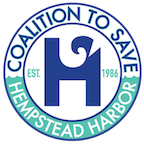Volunteer Sessions Underway
The spat-on-shell oysters delivered on July 16 have been acclimating to their summer homes (their cages). Volunteers for CSHH’s community oyster gardening program officially began cage maintenance and oyster observations on July 26 at the four locations around Hempstead Harbor.
Volunteers at North Hempstead Beach Park (8/3/24)
Volunteers at Tappen Marina measure oyster growth (8/10/24)
Volunteers are measuring a sample of oysters at each session and have already observed some impressive growth. Different types of wildlife are attracted to the cages, including shrimp, crabs, and various species of fish. We’ve been removing a lot of sea squirts, which are common on our oyster cages and settle all around the docks this time of year.
Spat-on-shell oysters at Sea Cliff Yacht Club (7/29/24)
Volunteers at Sea Cliff Yacht Club (7/29/24)
Due to the recent heat and heavy rain, nutrient runoff into Hempstead Harbor has led to substantial algal growth around the cages. This thick algal coverage is a major contributor to the biofouling that volunteers diligently remove during their sessions. If the oysters and their cages become encrusted with algae and other forms of biofouling from marine organisms such as sea squirts (a type of tunicate), the oysters lose vital access to sufficient water flow and face survival challenges. Given their small size, these oysters are especially vulnerable to the effects of biofouling. This is why volunteers are so important for the program.
Volunteers at Hempstead Harbour Club (7/26/24)
Spat-on-shell oysters at Sea Cliff Yacht Club (8/11/24)







